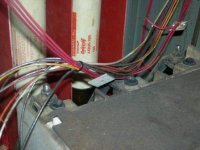Kev77
Member
I had an issue with a refiner at our plant yesterday and I was surprised to see the cause. We have a refiner that operates 2 800 HP motors and the control voltage is 120. There was a bundle of wires that ran in the starter cabinet that were used for various limit switches and such. Whoever installed it thought it would be a good idea to secure the bundle to the top of the cabinet with the sticky back zip tie blocks. What we found was the bundle had come loose and fallen onto the top of the mains connection. After a period of time one of the wires rubbed and from our best guess, shorted between 2 phases. I was standing in front of the cabinet working in the 120V section of the cabinet trying to see why the amp signal was not going back to the PLC. Just before I hooked up my process meter there was an explosion and a bundle caught fire. After everything was said and done we had to replace 3 output cards, several din rail fuse blocks, a UPS, and lots of wire. If we didn't have the UPS it could have been much more expensive. The reason for this post is I have a few question;
1. The wire that caused the failure tripped the breaker in our substation. The wire was a #16 THHN. The breaker in the substation feeds 2 Refiners, one has two 800HP motors and the other has one 1000HP motor. How can the #16 wire cause that kind of trouble? I would think the wire would have melted and the motor would have kept running.
2. The rating in the #16 wire is 600VAC I think. If that is the case, did the insulation wear through or could it be caused by the wire just touching the lug.
3. At the same moment we had another breaker trip that is feed from a separate transformer and runs at 480vac. It is a 250hp motor on a VFD. The VFD had a fault of "over current". Are these events related?
Got a pic of the bundle if anyone is interested...
Thanks,
Kevin
1. The wire that caused the failure tripped the breaker in our substation. The wire was a #16 THHN. The breaker in the substation feeds 2 Refiners, one has two 800HP motors and the other has one 1000HP motor. How can the #16 wire cause that kind of trouble? I would think the wire would have melted and the motor would have kept running.
2. The rating in the #16 wire is 600VAC I think. If that is the case, did the insulation wear through or could it be caused by the wire just touching the lug.
3. At the same moment we had another breaker trip that is feed from a separate transformer and runs at 480vac. It is a 250hp motor on a VFD. The VFD had a fault of "over current". Are these events related?
Got a pic of the bundle if anyone is interested...
Thanks,
Kevin






